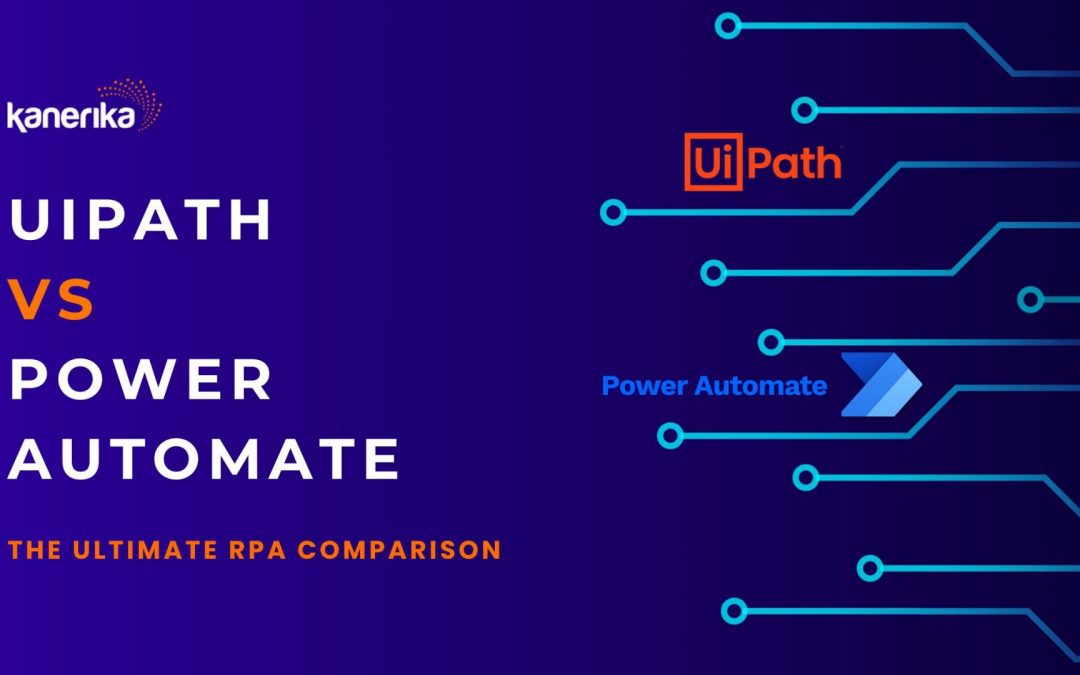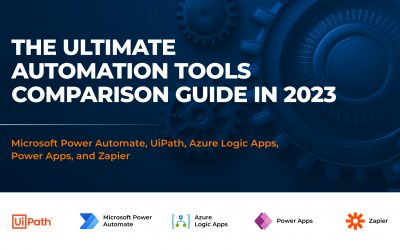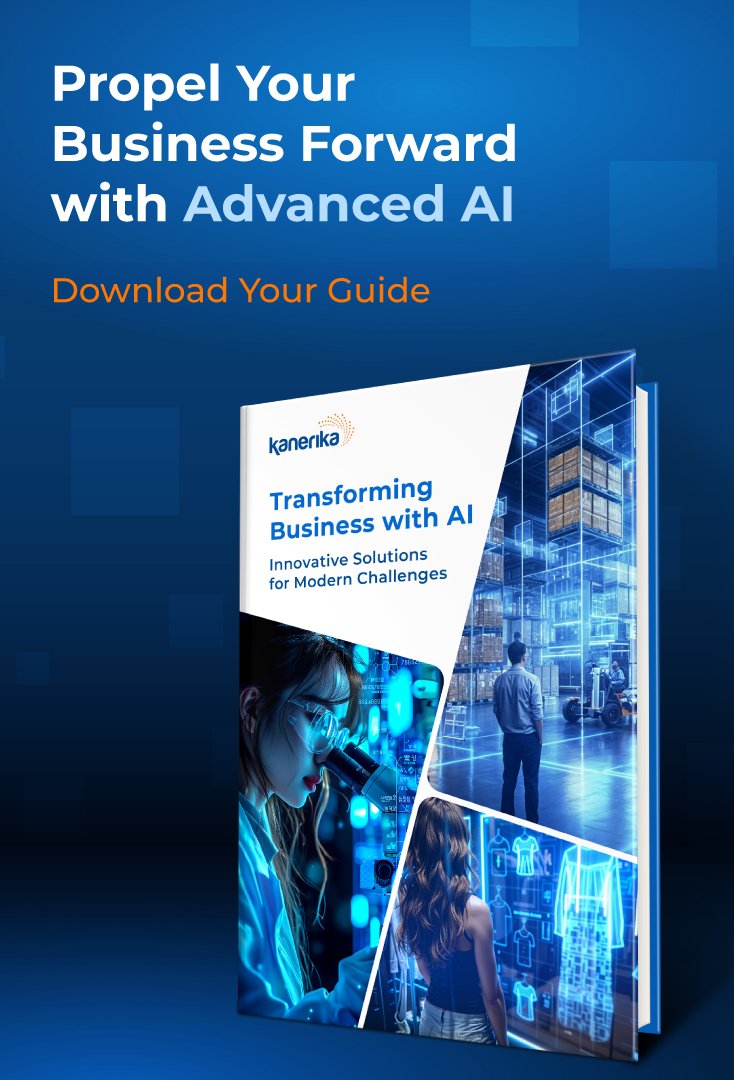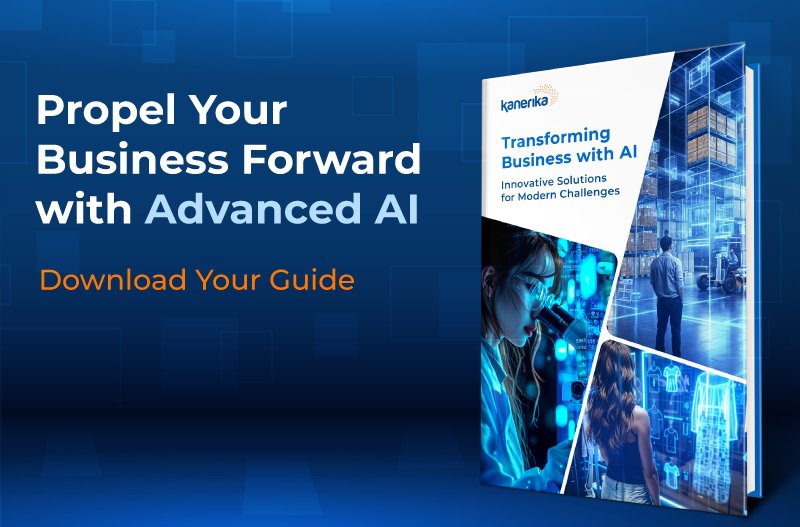Businesses have always wanted a solution to the ever-existing challenge of dealing with repetitive and menial tasks within an organization.
Employees hate them, and businesses lose out on valuable time and employee productivity that could have been redirected towards more important tasks.
The solution?
Robotic Process Automation. RPA has become a sensation since its inception, echoing the famous words of Amber Rudd, “Automation is driving the decline of banal and repetitive tasks.”
According to estimates, the global RPA market size was valued at USD 10.01 billion in 2022. It is expected to reach USD 50.50 billion by 2030, at a CAGR of 20.3% – a staggering rise.
However, due to this growth, there is an abundance of different RPA tools and technologies on the market, which can be difficult for businesses to choose from. Two of the most popular RPA tools that dominate the market are UiPath and Microsoft Power Automate.
Let’s take a deep dive into the UiPath vs Power Automate debate and examine all aspects, to understand which tool works best for your business.
Table of Contents
- UiPath vs Power Automate: Understanding the Differences
- UiPath vs Power Automate: Use Cases
- UiPath vs Power Automate: Features
- UiPath vs Power Automate: Architecture
- UiPath vs Power Automate: Pricing Models
- UiPath vs Power Automate: Learning Curve
- UiPath vs Power Automate: Comparison Summary
- UiPath vs Power Automate – Which One is Right for You?
- Kanerika: Your Partner for RPA Implementation
- FAQs
UiPath vs Power Automate: Understanding the Differences
Despite both being RPA tools, UiPath and Power Automate offer a multitude of functionalities that each cater to different use cases. Let’s take a deeper look at each tool and understand their origins and differences.
What is UiPath?
UiPath Inc. was founded in 2005 in Bucharest, Romania, by Daniel Dines and Marius Tîrcă. The company has since relocated its headquarters to New York City.
UiPath’s rise in the RPA market was rapid. By 2019, it was ranked #1 in RPA market share by Gartner.
UiPath’s products focus on automating digital tasks using AI and machine learning, with applications ranging from internal processes like accounting to customer management.
What is Power Automate?
Power Automate, was previously known as Microsoft Flow. It is a software as a service (SaaS) platform by Microsoft designed for automating recurring tasks.
It is a part of the Microsoft Power Platform, which includes other products like Power Apps and Power BI.
Power Automate offers a range of powerful flows that aim to streamline workflows and enhance productivity.
UiPath vs Power Automate: Use Cases
Understanding the practical applications of UiPath and Power Automate can help businesses make an informed choice between these two leading RPA tools. Each platform has its own unique strengths and is suited for different types of automation tasks.
UiPath Use Cases

UiPath is renowned for its comprehensive automation capabilities, particularly in complex process automation and integration with various systems. Its use cases are significant for businesses looking to automate intricate and high-volume tasks.
- Financial Process Automation: UiPath is highly effective in automating complex financial processes such as accounts payable and receivable, budgeting, and financial reporting. By integrating with various financial systems, UiPath can streamline these processes, reduce errors, and ensure compliance.
- Customer Service Automation: UiPath can automate several customer service tasks such as ticketing, customer query responses, and feedback collection. Its ability to integrate with CRM systems and leverage AI and machine learning enhances customer interactions and improves overall service efficiency.
- Healthcare Data Management: In the healthcare sector, UiPath is utilized to manage patient data, schedule appointments, and automate billing processes. Its advanced data processing capabilities ensure accuracy and compliance with healthcare regulations, thereby improving patient care and operational efficiency.
Power Automate Use Cases

Power Automate is a versatile tool within the Microsoft ecosystem, known for its ease of use and integration with common business applications. It’s particularly useful for businesses seeking to automate workflows and data processes within the Microsoft environment.
- Workflow Automation in Office 365: Power Automate is commonly used to automate workflows within the Office 365 suite. For instance, it can automate the process of file approvals in SharePoint, email notifications in Outlook, and data synchronization between different Office applications.
- Data Integration and Synchronization: Power Automate excels in integrating and synchronizing data across various platforms. It can be used to automatically update databases, transfer data between different applications, and maintain consistency of information across an organization’s digital ecosystem.
- Event-driven Notifications: Power Automate allows businesses to set up automated, event-driven notifications. For example, it can send real-time alerts based on specific triggers in a CRM system or monitor social media channels for brand mentions and automatically generate responses or reports.
UiPath vs Power Automate: Features
When choosing between UiPath and Power Automate, understanding their core features is crucial. Each platform brings distinct capabilities to the table, with various differences in UI, security, and integrations.
Core Features of UiPath
- Drag and Drop Workflow: UiPath enables users to develop visual process steps by dragging and dropping related tasks. This feature simplifies the creation of automation workflows.
- High Scalability and Flexibility: The RPA tool is designed to be highly scalable. It can cater to the needs of both small businesses and large enterprises. UiPath offers flexibility in terms of deployment and usage.
- Advanced Screen Scraping Solution: UiPath provides a robust screen scraping solution. It works with multiple application types, including web and desktop applications. This feature is crucial for extracting data from screens for automation purposes.
- Centralized Repository: The platform offers a centralized repository for storing and managing all automation artifacts. This ensures better control, and collaboration among team members.
- Robust Security Features: UiPath places a strong emphasis on security, offering features like secure credential management and encryption.
- Advanced Analytics and Reporting: The platform includes advanced analytics and reporting capabilities. Businesses can track the performance of their RPA operations and gain insights for optimization.
- Integration with Various Tools and Platforms: UiPath integrates seamlessly with tools and platforms, including ERP systems, productivity tools, and AI services. This enhances its automation capabilities.
- User-Friendly Interface: The platform is designed with a user-friendly interface. This makes it accessible for users with different levels of technical expertise and reduces the learning curve.
Core Features of Power Automate
- Templates and Pre-built Flows: Power Automate provides a variety of templates and pre-built flows. These allow users to quickly start automating common business processes.
- Workflow Automation: Users can create custom workflows to automate routine tasks. These workflows can integrate various applications and services, streamlining operations and improving efficiency.
- AI Integration: Power Automate incorporates AI capabilities, allowing for more intelligent and adaptive solutions. This includes features like AI Copilot, which assists in creating flows.
- Data Synchronization and Notifications: The platform enables synchronization of files across different applications and services. It also allows for the setup of notifications and alerts based on specific events within workflows.
- API Connectivity: Power Automate offers extensive API connectivity. This enables users to integrate and automate tasks across a wide range of applications and services.
- User-friendly Interface: The platform has an easy to learn UI, making it accessible to everyone in the organization.
- Collaboration Tools: It offers improved collaboration among team members by automating shared tasks and processes.
- Customization and Flexibility: Power Automate allows for a high degree of customization. Expert users can tailor workflows to their specific business needs.
UiPath vs Power Automate: Architecture
UiPath and Power Automate are both excellent RPA tools. However, they have different architectural frameworks, which ultimately change their approach towards RPA.
UiPath Architecture and Components
UiPath’s architecture is sophisticated, designed for robustness and scalability. It employs a multi-node deployment strategy, particularly effective in large-scale, complex enterprise environments.
UiPath’s Three-Layered Architecture:
- Client Layer: This layer comprises UiPath Studio for designing RPA workflows, the Robot that executes these workflows, and a Browser component facilitating web application interactions.
- Server Layer: Includes the Orchestrator for deployment, scheduling, and management of RPA bots and processes, and a Database for storing configurations and logs.
- Persistency Layer: Ensures reliable data storage and logging, crucial for audits and monitoring.
Additional Architecture Components:
- Multi-Site Deployment: UiPath’s architecture takes into account various factors like infrastructure, data source management, Recovery Time Objective (RTO), and Recovery Point Objective (RPO), ensuring robustness and reliability.
- Multi-Node Deployment: UiPath’s deployment can be configured on Linux with Kubernetes, including server nodes, agent nodes, and specialized agent nodes for specific tasks like Task Mining and Robot execution
Power Automate Architecture and Components
The architecture in Power Automate is inspired by the Azure hub-and-spoke network topology, focusing on workflow and process automation within the Microsoft ecosystem.
Power Automate’s Hub-and-Spoke Inspired Architecture:
- Workflow Management: Utilizes parent and child flows for efficient management, avoiding overly complex workflows with numerous steps.
- Key Architecture Components:
- Power Automate for automated process building.
- SharePoint Online sites for content and application management.
- Power Platform environments and solutions for data and application lifecycle management (ALM).
- Use Case Flexibility: Suits both ad-hoc workflow creations by SharePoint site owners and more managed, IT team-driven workflows.
UiPath vs Power Automate: Pricing Models
The pricing models of UiPath and Power Automate vary, offering different tiers and options that cater to a range of requirements, from individual use to enterprise-level automation.
| Pricing Plan | UiPath | Power Automate |
| Pricing Plan 1 | Free Access: Personal use, development, attended capabilities, unlimited runs, design tools, prebuilt integrations | Free Trial available |
| Pricing Plan 2 | Pro Plan: $420/month for small departments/businesses, advanced tools | Premium Plan: $15/user/month, unlimited cloud/desktop flows, AI Builder credits, Dataverse entitlements |
| Pricing Plan 3 | Enterprise Plan: Flexible services for comprehensive platform, cloud/on-premises. Pricing is decided based on individual requirements | Process Plan: $150/bot/month, single automation bot for unattended RPA/DPA, Dataverse entitlements |
In addition to the above custom plans, Power Automate also offers a flexible $0.60 per flow run that includes Power Automate cloud flow run and desktop flow run.
UiPath vs Power Automate: Learning Curve
Here’s a brief overview of the learning curves for both UiPath and Power Automate:
UiPath Balances Complexity with Dedicated Courses
The learning curve for UiPath can vary depending on the user’s background. Those with a programming background can master it in a week of intensive learning. Learning the advanced features could take a few weeks.
UiPath estimates 40 hours are required to complete the Foundation course and 5 hours for the Orchestrator module. UiPath Academy offers various training courses for different roles in RPA. After each video in the UiPath Academy, there is a quiz to ensure understanding of the learned content.
Power Automate Offers a Seamless, Easy-to-Use UI
The learning curve for Power Automate is described as “objective-oriented”. This means you need to know what you want to create or make.
The UI is very easy, and users do not need to write HTML or CSS. Some reviewers mention that Power Automate needs little to no learning curve.
UiPath vs Power Automate: Comparison Summary
Here’s a quick comparison table that illustrates the primary differences between both the leading RPA tools:
| Aspect | UiPath | Power Automate |
| Origin | Founded in 2005 in Bucharest, Romania | Previously known as Microsoft Flow, part of Microsoft Power Platform |
| Market Status | Ranked #1 in RPA market share by Gartner in 2019 | A major player in RPA market, known for integration with Microsoft products |
| Key Focus | Automating digital tasks using AI and ML | Automating recurring tasks, part of a broader suite of tools |
| Use Cases |
|
|
| Core Features |
|
|
| Architecture | Sophisticated multi-node deployment, three-layered architecture | Hub-and-spoke inspired architecture, focused on workflow automation within Microsoft ecosystem |
| Pricing Models |
|
|
| Learning Curve | Varies based on user background, estimated 40 hours for Foundation course | Described as “objective-oriented”, little to no learning curve for basic tasks |
UiPath vs Power Automate – Which One is Right for You?

Deciding between UiPath and Power Automate hinges on your specific business needs, technical requirements, and the scale of your automation ambitions.
UiPath is well-suited for organizations seeking robust, AI-enhanced automation capabilities, especially in complex processes and large-scale deployments.
Its user-friendly interface, coupled with advanced features like elastic scalability, makes it a strong choice for businesses with diverse and evolving automation requirements.
Power Automate, on the other hand, excels in its integration within the Microsoft ecosystem, offering seamless workflow automation, particularly for Office 365 users.
Its low-code approach and cloud-based solutions are ideal for businesses looking for rapid deployment and scalability, especially for those already entrenched in Microsoft’s services.
Ultimately, the choice depends on your organization’s existing infrastructure, technical expertise, and long-term automation strategy.
UiPath offers a more comprehensive, enterprise-level solution, while Power Automate provides ease of use and integration for businesses heavily reliant on Microsoft products.
Kanerika: Your Partner for RPA Implementation
At Kanerika, we understand the transformative power of RPA in streamlining and optimizing business processes.
With our deep expertise in platforms like UiPath and Power Automate, we are uniquely positioned to help businesses harness the full potential of RPA.
Whether it’s enhancing efficiency in healthcare or driving innovation in banking, our approach focuses on delivering scalable and sustainable automation solutions.
Our extensive experience, evidenced by over 150 automated processes and more than 1000 bots in operation, and our breadth of knowledge across various RPA platforms position us as an ideal partner for your digital transformation journey.














